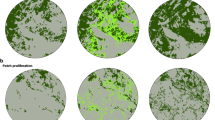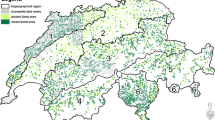Abstract
Introduction
Spatio-temporal forest changes can have a progressive negative impact on the habitat of species that need forest continuity, i.e. the continuous presence of forest. Long-term species data that demonstrate such an impact are often not available. Instead we applied a spatial analysis on maps of the historical and present-day forests, by calculating landscape indices that explain forest plant species diversity.
Methods
We digitized for this purpose, forests in Flanders (northern Belgium, ~13,500 km2) at four time slices (1775, 1850, 1904–1931, 2000) and created a map of forest continuity in 2000. The ecological relevance of the analysis was further enhanced by a site classification, using a map of potential forest habitat types based on soil–vegetation relationships.
Results
Our results indicated that, between 1775 and 2000, forests occupied 9.7–12.2 % of the total study area. If continuity was not taken into consideration, forest fragmentation slightly increased since 1775. However, only 16 % of the forest area in 2000 remained continuously present at least since 1775 and is therefore called ancient forest (AF). Moreover, connectivity of forest that originated after 1775, called recent forest, was low and only 14 % was in physical contact with AF. The results were habitat-specific as forest on sites that are potentially suitable for a high number of slow-colonizing species, e.g. ancient forest plants, were affected most.
Conclusion
We discuss that a GIS analysis of this kind is essential to provide statistics for forest biodiversity conservation and restoration, in landscapes with a dynamic and heterogeneous forest cover.




Similar content being viewed by others
References
AGIV (2001) Digital forest reference layer 2000. Flemish Geographical Information Agency and the Nature and Forest Agency of the Flemish Community. http://metadata.agiv.be/Details.aspx?fileIdentifier=63D62DD2-E800-4406-BF59-74DF33D109E1. Accessed Feb 2013
Andrieu E, Ladet S, Heintz W, Deconchat M (2011) History and spatial complexity of deforestation and logging in small private forests. Landsc Urban Plan 103:109–117
Assmann T (1999) The ground beetle fauna of ancient and recent woodlands in the lowlands of north-west Germany (Coleoptera, Carabidae). Biodivers Conserv 8:1499–1517
Batek MJ, Rebertus AJ, Schroeder WA, Haithcoat TL, Compas E, Guyette RP (1999) Reconstruction of early nineteenth century vegetation and fire regimes in the Missouri Ozarks. J Biogeogr 26:397–412
Bolliger J, Schulte LA, Burrows SN, Sickley TA, Mladenhoff DJ (2004) Assessing ecological restoration potentials of Wisconsin (USA) using historical landscape reconstructions. Restor Ecol 12(1):124–142
Bos+ (2012) Bosbarometer 2012: waar blijven de daden? Bos+, Melle. http://www.bosplus.be/images/stories/kenniscentrum/bosbeleid/bosbarometer/. Accessed Jan 2013
Brunet J, De Frenne P, Holmström E, LajosMayr M (2012) Life-history traits explain rapid colonization of young post-agricultural forests by understory herbs. For Ecol Manag 278:55–62
Burnicki AC (2012) Impact of error on landscape pattern analyses performed on land-cover change maps. Landscape Ecol 27:713–729
Carstensen B, Plummer M, Laara E, Hills M (2013) Epi: A Package for Statistical Analysis in Epidemiology. R package version 1.1.49. http://CRAN.R-project.org/package=Epi Accessed May 2014
Cornelis J, Hermy M, Roelandt B, De Keersmaeker L, Vandekerkhove K (2009) Bosplantengemeenschappen in Vlaanderen, een typologie van bossen gebaseerd op de kruidlaag. Agentschap voor Natuur en Bos en Instituut voor Natuur- en Bosonderzoek, Brussels
Cousins SA (2001) Analysis of land cover transitions based on 17th and 19th century cadastral maps and aerial photographs. Landscape Ecol 16:41–54
De Clercq EM, Clement L, De Wulf RR (2009) Monte Carlo simulation of false change in the overlay of misregistered forest vector maps. Landsc Urban Plan 91:36–45
De Frenne P, Baeten L, Graae BJ, Brunet J, Wulf M, Orczewska A, Kolb A, Jansen I, Jamoneau A, Jacquemyn H, Hermy M, Diekmann M, De Schrijver A, De Sanctis M, Decocq G, Cousins SA, Verheyen K (2011) Interregional variation in the floristic recovery of post-agricultural forests. J Ecol 99:600–609
De Keersmaeker L, Vandekerkhove K, Verstraeten A, Baeten L, Verschelde P, Thomaes A, Hermy M, Verheyen K (2011) Clear-felling effects on colonization rates of shade tolerant forest herbs into a post-agricultural forest adjacent to ancient forest. Appl Veg Sci 14:75–83
De Keersmaeker L, Rogiers N, Vandekerkhove K, De Vos B, Roelandt B, Cornelis J, De Schrijver A, Onkelinx T, Thomaes A, Hermy M, Verheyen K (2013) Application of the ancient forest concept to Potential Natural Vegetation mapping in Flanders, a strongly altered landscape in Northern Belgium. Folia Geobotanica 48:137–162
Desender K, Ervynck A, Tack G (1999) Beetle diversity and historical ecology of woodlands in Flanders. Belg J Zool 129:139–156
Dondeyne S, Van Ranst E, Deckers J (2012) Converting the legend of the soil map of Belgium into the World Reference Base for soil resources. KU Leuven and UGent, Leuven
Fensham RJ, Fairfax RJ (1997) The use of the land survey record to reconstruct pre-European vegetation patterns in the Darling Downs, Queensland, Australia. J Biogeogr 24:827–836
Foster DR (1992) Land-use history (1730-1990) and vegetation dynamics in central New England, USA. J Ecol 80:753–771
Fritz Ö, Gustafsson L, Larsson K (2008) Does forest continuity matter in conservation?—A study of epiphytic lichens and bryophytes in beech forests of southern Sweden. Biol Conserv 141:655–668
Hall B, Motzkin G, Foster DR, Syfert M, Burk J (2002) Three hundred years of forest and land-use change in Massachusetts, USA. J Biogeogr 29:1319–1335
Hermy M, Honnay O, Firbank L, Grashof-Bokdam C, Lawesson JE (1999) An ecological comparison between ancient and other forest plant species of Europe, and the implications for forest conservation. Biol Conserv 91:9–22
Honnay O, Verheyen K, Butaye J, Jacquemyn H, Bossuyt B, Hermy M (2002) Possible effects of habitat fragmentation and climate change on the range of forest plant species. Ecol Lett 5:525–530
IUSS Working Group WRB (2006) World reference base for soil resources 2006. A framework for international classification, correlation and communication. World soil resources report 103, FAO, Rome
Iverson LR (1988) Land-use changes in Illinois, USA: the influence of landscape attributes on current and historic land use. Landscape Ecol 2:45–61
Jacquemyn H, Butaye J, Hermy M (2001) Forest plant species richness in small, fragmented mixed deciduous forest patches: the role of area, time and dispersal limitation. J Biogeogr 28:801–812
Jacquemyn H, Butaye J, Hermy M (2003) Impacts of restored patch density and distance from natural forests on colonization success. Restor Ecol 11:417–423
Leyk S, Boesch R, Weibel R (2005) A conceptual framework for uncertainty investigation in map-based land cover change modeling. Trans GIS 9:291–322
Lindbladh M, Brunet J, Hannon G, Niklasson M, Eliasson P, Eriksson G, Ekstrand A (2007) Forest history as a basis for ecosystem restoration—a multidisciplinary case study in a south Swedish temperate landscape. RestorEcol 15(2):284–295
Matlack GR (2005) Slow plants in a fast forest: local dispersal as a predictor of species frequencies in a dynamic landscape. J Ecol 93(1):50–59
Metz CE (1978) Basic principles of ROC analysis. Semin Nucl Med 8:283–298
Ministerial Conference on the Protection of Forests in Europe (1998) Annex 2 of the resolution L2, Pan-European Operational Level Guidelines for Sustainable Forest Management. Adopted at the Fifth Expert Level Preparatory Meeting of the Lisbon Conference on the Protection of Forests in Europe, 27–29 April 1998, Geneva, Switzerland. http://www.foresteurope.org/docs/MC/MC_lisbon_resolution_annex2.pdf. Accessed June 2013
Ministerial Conference on the Protection of Forests in Europe (2009) Pan-European guidelines for afforestation and reforestation with a special focus on the provisions of the UNFCCC. Adopted by the MCPFE Expert Level Meeting on 12–13 November 2008 and by the PEBLDS Bureau on behalf of the PEBLDS Council on 4 November 2008.http://www.foresteurope.org/documentos/Pan-EuropeanAfforestationReforestationGuidelines.pdf. Accessed June 2013
Montréal Process Criteria and Indicators for the Conservation and Sustainable Management of Temperate and Boreal Forests (2009) Technical notes on implementation of the Montréal Process criteria and indicators, criteria 1–7, third edition available from http://www.montrealprocess.org/documents/publications/techreports/2009p_2.pdf. Accessed May 2014
Nordén B, Appelqvist T (2001) Conceptual problems of ecological continuity and its bioindicators. Biodiversity Conserv 10:779–791
Peterken G (2000) Rebuilding networks of forest habitats in lowland England. Landsc Res 25:291–303
Peterken GF, Game M (1984) Historical factors affecting the number and distribution of vascular plant species in the woodlands of central Lincolnshire. J Ecol 72:155–182
Ponge JF, Dubs F, Gillet S, Sousa JP, Lavelle P (2006) Decreased biodiversity in soil springtail communities: the importance of dispersal and landuse history in heterogeneous landscapes. Soil Biol Biochem 38:1158–1161
Riitters KH, Coulston JW, Wickham JD (2003) Localizing national fragmentation statistics with forest type maps. J Forest 101:18–22
Sereda S, Lukana M (2009) Assessment of changes in land-use development in the Magura and the Eastern Tatras in the years 1772–2003. Oecol Mont 18:1–13
Skalos J, Engstova B, Trpakova I, Santruckova M, Podrazsky V (2012) Long-term changes in forest cover 1780–2007 in central Bohemia, Czech Republic. Eur J Forest Res 131:871–884
Spencer JW, Kirby KJ (1992) An inventory of ancient woodland for England and Wales. Biol Conserv 62:77–93
R Development Core Team (2014). R: A language and environment for statistical computing. R Foundation for Statistical Computing, Vienna, Austria. ISBN 3-900051-07-0, http://www.R-project.org/. Accessed May 2014
Van Landuyt W, Hoste I, Vanhecke L, Van Den Bremt P, Vercruysse W, de Beer D (2006) Atlas van de flora van Vlaanderen en het Brussels Gewest. Flower, Research Institute for Nature and National Botanic Garden of Belgium, Brussels
Vellend M (2003) Habitat loss inhibits recovery of plant diversity as forests regrow. Ecology 84:1158–1164
Vellend M, Verheyen K, Jacquemyn H, Kolb A, Van Calster H, Peterken G, Hermy M (2006) Extinction debt of forest plants persists for more than a century following habitat fragmentation. Ecology 87:542–548
Verheyen K, Hermy M (2001) The relative importance of dispersal limitation of vascular plants in secondary forest succession in Muizen Forest, Belgium. J Ecol 89:829–840
Verheyen K, Bossuyt B, Hermy M, Tack G (1999) The land use history of a mixed hardwood forest in western Belgium and its relationships with chemical soil characteristics. J Biogeogr 26:1115–1128
Verheyen K, Fastenaekels I, Vellend M, De Keersmaeker L, Hermy M (2006) Landscape factors and regional differences in recovery rates of herb layer richness in Flanders (Belgium). Landscape Ecol 21:1109–1118
Waterinckx M, Roelandt B (2001) De bosinventaris van het Vlaamse Gewest. Ministerie van de Vlaamse Gemeenschap, afdeling Bos and Groen, Brussel
Wickham JD, Riiters KH, Wade TG, Coulston JW (2007) Temporal change in forest fragmentation at multiple scales. Landscape Ecol 22:481–489
Wulf M (2003) Forest policy in the EU and its influence on the plant diversity of woodlands. J Environ Manag 67:15–25
Wulf M, Gross J (2004) Application of the historical Schmettau map (1767–1787) in landscape analysis. In: Verhandlungen der Gesellschaft für Ökologie, Band 34, Giessen, 13–17 September 2004
Wulf M, Rujner H (2011) A GIS-based method for the reconstruction of the late eighteenth century forest vegetation in the Prignitz region (NE Germany). Landscape Ecol 26:153–168
Wulf M, Sommer M, Schmidt R (2010) Forest cover changes in the Prignitz region (NE Germany) between 1790 and 1960 in relation to soils and other driving forces. Landscape Ecol 25:299–313
Acknowledgments
We would like to thank Marc Esprit who accomplished most of the laborious digitization work, and the Nature and Forest Agency who put the forest inventory sample points to our disposal. This research was the result of project VLINA/C97/06b, funded by the Flemish Community.
Author information
Authors and Affiliations
Corresponding author
Electronic supplementary material
Below is the link to the electronic supplementary material.
Rights and permissions
About this article
Cite this article
De Keersmaeker, L., Onkelinx, T., De Vos, B. et al. The analysis of spatio-temporal forest changes (1775–2000) in Flanders (northern Belgium) indicates habitat-specific levels of fragmentation and area loss. Landscape Ecol 30, 247–259 (2015). https://doi.org/10.1007/s10980-014-0119-7
Received:
Accepted:
Published:
Issue Date:
DOI: https://doi.org/10.1007/s10980-014-0119-7




